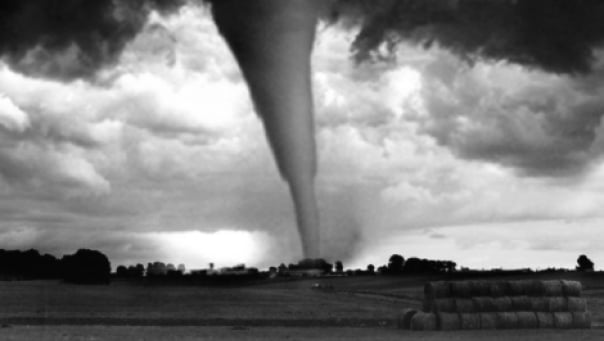Dream

The dreamer finds herself standing in front of a window, transfixed while she admires the aesthetics of rapidly approaching tornados. This a very powerful orientation to begin to understand the dream. One does not need to know anything about the dreamer or her associations to the dream to know the most salient fact about a tornado: it is a violently destructive windstorm moving across the ground that is characterized by a funnel-shaped cloud (Pickett, 2000). The consequence of a tornado that touches ground can vary from moderate destruction to total devastation.
The image of a tornado carries with it a “specific field” of information. It is not just any type of storm; it is a violent and dangerous storm. Although it is true that there may be a wide variety of responses to sighting a tornado, ranging from utter horror to quiet fascination and awe. However, one does not have to be tornado expert to know what the most common response would be. One would run for cover in an attempt to escape the approaching danger as rapidly as possible. This response would be likely even for a person who has little knowledge of tornadoes. Human beings have an almost instinctual survival sense that alerts them when natural conditions are threatening.
Nevertheless, the dreamer finds herself standing in front of a window watching the approaching storm and admiring its beauty. This is not a fully appropriate reaction. Thus dreamer’s response sends up a red directional flag, telling much about what the dream is trying to communicate. The image (a stabilized repeated pattern), its information (like a vibrational or morphic field), and the dreamer’s response to the image in the dream indicates that in her life a dangerous and possibly life-threatening situation may be approaching. Furthermore, the dreamer to some degree is probably consciously aware of this. However, the dreamer is not reacting to the impending peril in a life-preserving manner but is enthralled and sees the danger as beautiful. If the presented approach to interpretation of the dream is accurate, it should be borne out in other areas of the dreamer’s life. What is likely to be found from examination is that the dreamer has previously been, and continues to be, entranced by situations of danger.
The common approach to understanding dreams today derives primarily from the subjective relativity of the dreamer’s associations. All of the thoughts, feelings, fantasies, and ideas that come to the dreamer about the dream images are explored and constitute the basis for understanding the dream. The dreamer is asked what she associates with the image of a tornado. She might, for instance, recall that as a child she loved to watch storms with her father (not tornadoes, but storms); she might further state that the memory gives her feelings of love and connection. If this associative information were to be used as the main point of orientation to understand the dream, it would lead to different conclusions to to the one has been presented.
I find myself standing in front of a very large window. I look out and see a rapidly moving tornado approaching, headed directly towards me. I am in awe and almost frozen and fascinated by its beauty.
Understanding the dream
In looking at this dream and beginning to understand its message, one does not have to be a tornado expert to know the most common response in this situation. The image of a tornado carries with it a specific field of information. It is not just any type of storm. It is violent and dangerous, while it is true a wide variety of responses ranging from utter horror to quiet fascination The most common response would be to escape the danger as rapidly as possible. This response would be likely even for a person who has little knowledge about tornadoes. Human beings have an almost intrinsic survival sense that alert them when natural conditions are threatening.
Nevertheless, the dreamer finds herself standing in front of a window watching the approaching storm and admiring its beauty. This is not a fully appropriate reaction. The dreamer’s response in the dream is a red flag, telling much about what the dream is trying to communicate. The image is a repeated stabilized pattern and the dreamer’s response to the image indicates that in her life a dangerous situation may be approaching.
the dreamer finds himself standing in front of a window, transfixed while she admires the aesthetics of a rapidly approaching tornado. Here a very powerful orientation has been given to begin to understand the dream. The dream analyst needs to know nothing about the dreamer or her associations to the dream to know the most salient fact about a tornado: it is a violently destructive windstorm moving across the ground that is characterized by a funnel-shaped cloud (Pickett, 2000). The consequence of a tornado that touches ground can vary from moderate destruction to total devastation.
The image of a tornado carries with it a specific field of information. It is not just any type of storm; it is a violent and dangerous storm. Although it is true that there may be a wide variety of responses to sighting a tornado, ranging from utter horror to quiet fascination and awe, one does not have to be tornado expert to know what the most common response would be. One might run for cover and attempt to escape danger as rapidly as possible. This response would be likely even for a person who has little knowledge of tornadoes. Human beings have an almost instinctual survival sense that alerts them when natural conditions are threatening.
Nevertheless, the dreamer finds herself standing in front of a window watching the approaching storm and admiring its beauty. This is not a fully appropriate reaction. Thus dreamer’s response sends up a red directional flag, telling much about what the dream is trying to communicate. The image (a stabilized repeated pattern), its information (like a vibrational or morphic field), and the dreamer’s response to the image in the dream indicates that in her life a dangerous and possibly life-threatening situation is approaching. Furthermore, the dreamer to some degree is probably consciously aware of this. However, the dreamer is not reacting to the impending peril in a life-preserving manner but is enthralled and sees the danger as beautiful. If the present approach to interpretation of the dream is accurate, it should be borne out in other areas of the dreamer’s life. What is likely to be found from examination is that the dreamer has previously been, and continues to be, entranced by situations of danger.
The common approach to understanding dreams today derives primarily from the subjective relativity of the dreamer’s associations. All of the thoughts, feelings, fantasies, and ideas that come to the dreamer about the dream images are explored and constitute the basis for understanding the dream. The dreamer is asked what she associates with the image of a tornado. She might, for instance, recall that as a child she loved to watch storms with her father (not tornadoes, but storms); she might further state that the memory gives her feelings of love and connection. If this associative information were to be used as the main point of orientation to understand the dream, it would lead to very different conclusions.



